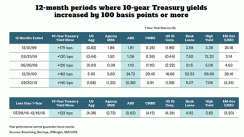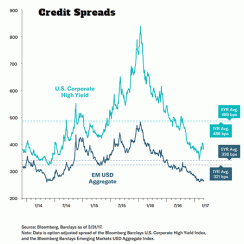To view a PDF of the report, click here.
After the excitement of late 2016, when the surprise victor in the U.S. presidential election kicked off a spate of optimism about U.S. growth, the bond markets have settled back into a lower-risk but lower-than-average return cycle. Rates look likely to rise in the U.S., while the Fed is looking to reduce its holdings of mortgage-backed securities.
Central banks in Europe and Japan are backing away from the extraordinary accommodative measures put in place after the global credit crisis. Optimism about the stimulating effects of tax reform, deregulation and infrastructure investment in the U.S. are fading, as market observers begin to doubt that the Trump administration will be able to push through its aggressive agenda.
In short, everything is returning to normal, and most bond managers see a quiet year of muted risks and modestly positive returns ahead. That’s the kind of environment that should make institutional investors consider a reset of their default positioning — whatever it is — based on the outcomes they seek from fixed income: stability, income, additional yield or some combination of the three.
“Asset allocation strategists are taking a look at fixed-income portfolio allocation now that the Fed has started raising rates again,” says Andrew McCormick, a Vice President and Fixed Income Portfolio Manager at T. Rowe Price Group. “Now that longer rates have reached some type of equilibrium for now, investors who want to stabilize their portfolios against volatility in the stock market have had an opportunity to extend duration at better yields than they could have last year. For investors who are nervous about ongoing increases in rates and think the economy is going to pick up, the opportunity set is more in floating rates and shorter duration.”
“The main message for fixed-income investors is that even with spreads and nominal yields at relatively low points in their historical experience, fixed income can play the role you want it to play,” says Tom Coleman, North America Senior Investment Specialist at Standard Life Investments. “It can play the role of being a great diversifier, in particular relative to equities. It can play the role of liquidity provider. It can generate coupon, and you can go in and out at the margins with some degree of efficiency to produce extra return. I think what investors need to do is to look beyond the conventional role of fixed income to different ways of approaching it to do the job they want it to do.”
Long recovery, no end in sight
Fixed-income specialists universally look for a relatively benign climate ahead, albeit one that offers little in the way of excitement. Says Coleman: “We’re in an environment that leans toward slower growth versus higher growth, and produces less demand for commodities and other factors that could lead to inflation. While there may be some volatility in single markets and single sectors, the overall trend continues to be one of very low or slow global growth.”
That’s the same trend that has been in place, more or less continuously, since the U.S. economy emerged from recession in 2009, and Coleman doesn’t see it ending anytime soon. “Credit cycles in particular last, on average, right around six or seven years. So we’re in the late stages of this credit cycle. But economic policies have evolved and credit has evolved — both things that can allow the recovery, slow that it might be, to continue almost indefinitely. There’s also no reason to believe that it’s going to get some type of jump-start,” he says.
Jeff Moore, a Portfolio Manager at Fidelity Investments who oversees diversified bond portfolios for both institutional and retail investors, concurs regarding continued slow growth. “It’s a long cycle, but I think we’re still mid-cycle,” says Moore. “I’m looking for positive GDP growth, but nothing super-fast.” He says that demographics will keep a lid on too much acceleration. “As our society ages and as the U.S. workforce gets to its peak level, it’s hard to imagine how we’ll see a productivity surge.”

In the U.S., the Fed started tightening last year and raised rates another quarter point in March, and has indicated it expects at least two more increases before 2017 ends. That move has, so far, not had a pronounced negative effect.
“We think it is worth pointing out that longer-term Treasuries saw a reasonably positive reaction to the Fed’s move on March 15. Longer-term interest rates did not immediately increase; initially, they actually decreased following the Fed’s announcement,” says Chris Molumphy, Executive Vice President and Chief Investment Officer of Franklin Templeton Fixed Income Group. “This disconnect between short- and long-term rates is important, as it dispels the basic notion that all fixed income is a poor investment in a rising short-rate environment,” he adds. “Fixed-income markets are vast and they are complex; good investment opportunities can be sourced within all different types of market environments.”
Monetary policy in other developed countries hasn’t yet made as definitive a turn, but the trend worldwide is clear. “Without question, the developed markets have seen the peak of monetary authorities being accommodative for the current cycle,” says Ashish Shah, Chief Investment Officer of Global Credit and Head of Fixed Income for AB. “In Japan, in Europe and in the U.S., we’ve seen different versions of either tapering or pulling back from engaging in heavy QE, or actually raising rates, in the case of the U.S.”

Shah also sees early signs of wage inflation picking up in developed markets, especially the U.S. “Whether that turns into a secular trend is a different question, since there are clear long-term, secular challenges, including automation and demographics. But cyclically, there’s no question that when you’re at 4.5 percent unemployment in the U.S., you want to see some growth in wages. We haven’t really seen a big pickup yet, but it would actually be a good thing for the economy.”
Fading political optimism
The relative stability of early 2017 comes after a flurry of euphoria kicked off by President Trump’s upset win last November. Salivating over campaign promises of lower taxes, less regulation and a significant infrastructure investment, the market priced in accelerating growth.
The Trump stock rally, which saw the S&P 500 rise by 12.41 points between Nov. 7, 2016 and a peak on March 1, may have grabbed all the headlines, but the bond market felt the impact, too. The 10-year Treasury yield moved from 1.83 percent on Nov. 7 to 2.62 percent by mid-March (about when the healthcare bill started unraveling), while the 30-year Treasury yield rose from 2.60 percent to 3.20 percent over the same period. High-yield bonds rallied sharply, with spreads contracting from around 500 basis points over Treasuries to a low of 350.
But fast-forward to early 2017: Healthcare is back-burnered on Capitol Hill, tax reform and infrastructure spending are on ice and markets have gone back to normal. Are investors starting to doubt that anything will get done?
“Some of the things that we expected after the election — a $1 trillion infrastructure spend, very significant tax cuts, the potential for big regulatory rollbacks and the call to bring jobs back to the U.S. — seem less likely to materialize,” says Coleman. “If you start to look at those things piece by piece, in terms of their probability of getting done and their probability of getting done in a way that is constructive for the credit cycle, you see things start to break down a little bit.”
“At this point, markets have reached an equilibrium where we’ll need to see some follow-through on policy shifts to ratify these levels,” says McCormick. “If that doesn’t take place, there’s a chance that we could move lower on yields at the long end, at least temporarily.”
Meanwhile, with recent air strikes in Syria and Afghanistan, and mounting tensions between the U.S. and North Korea, political factors have had a negative effect, with Treasury yields touching five-month lows following saber-rattling in mid-April. “No doubt the geopolitical environment has weighed on the markets,” says McCormick, speaking of rising tensions in Asia. “Those kinds of things are always very, very difficult to predict and, thankfully, they often end up settling rather than getting worse. In this case, the markets have been on a long run, and I think there’s an appetite to get a little safety in portfolios to see how things play out.”
U.S. is the place to be
The U.S. may have its problems in slow growth and an unpredictable political climate, but compared to other developed regions, it is doing very well. “Certainly the U.S. growth story might not be as optimistic as it was a couple of months ago, but the bottom line is that it is one of the shining lights globally from an economic perspective,” says Coleman.
Moore concurs that, at least among developed markets, America is where he’s putting his focus. “In the short end, with global developed rates negative, you have to be cautious. There’s not a lot there to do,” he says. He is encouraged by an uptick in Japan’s producer prices, indicating the possibility of slightly stronger growth and inflation, and he sees signs of growth in German GDP. “Even with immigration, population decline is another speed limit on the German economy,” he cautions. “But having said that, I think they’re in early cycle or mid-cycle in Europe. It’s probably positive once you get the negative return out of the way.”
Tactical bets on emerging markets
Emerging markets look a bit more promising, though a late 2016 rally has compressed spreads to Treasuries to about half their levels of a year ago. “A mix of factors make emerging-markets debt attractive,” says AB’s Shah. “We think that emerging-markets inflation rates will continue to converge with developed markets; that’s a multi-year theme.” Still, despite broad supportive trends, Shah says it’s important to take a tactical approach. “You have to be willing to buy countries on dislocations,” he explains. “Three months ago, if you were buying Brazilian assets, people thought that you were crazy, particularly if it was in local currency — and today they’ve been a very strong-performing asset. Being contrarian to headline risk is important when it comes to emerging markets.”
McCormick says that he is reducing his emerging-markets allocation after strong results in 2016. “We don’t expect a collapse, but, especially in dollar-based emerging markets, we feel like that’s fully priced at this point,” he says. Like Shah, he says that emerging-markets debt based in local currencies is a focus, and emphasizes South Africa, Brazil and Indonesia, though he notes that these securities tend to be volatile, and that a strong dollar tends to undermine returns.
The tail end of a high-yield rally
Like emerging markets, high yield was up dramatically in 2016, as the Bloomberg Barclays U.S. High Yield Index advanced 17.1 percent on the back of dramatic spread compression late in the year. “Looking at high-yield valuations on the basis of spread to Treasuries, relative to its own history, we can make the argument that the sector is beginning to look overvalued, given that this spread is a bit reduced from long-term averages,” says Molumphy. “However, we view the market fundamentals — investment-grade and below — as healthy, and the corporate outlook looks good to us.”
Moore says that, even though there’s little room for further capital appreciation, he still looks favorably on high yield in an environment of stable, steady growth. “I think the market’s right that spreads should be tight. I think that high-yield defaults will still be down year over year,” he explains, noting that the only really weak sector is retail, due to online shopping.
“I don’t think there are any sections of the U.S. high-yield market that I can point to and really expect spreads to run a lot tighter from here, because they have come a long way,” says McCormick. “But there’s value in the carry, or coupon rate, which cushions your portfolio against future rate increases.”
That reliance on the coupon makes issue selection more important than ever, says Coleman: “If the coupon is the only source of return, you’re going to be very concerned with the potential to lose that coupon. This is the type of environment where you’re being very careful about what you do buy, because it’s how you’re going to generate returns through this part of the cycle.”
A play on consumers through securitized debt
Securitized credit, or structured pools of homogenous debt, have changed dramatically since the end of the credit crisis, when regulators imposed stricter rules on leverage and disclosure. The market is now smaller, more tightly regulated and more transparent. David Goodson, Head of Securitized Products at Voya Investment Management, says the sector merits a permanent place in most institutional portfolios.
“People don’t necessarily understand where securitized credit fits into the asset allocation,” Goodson explains. “Is it part of a multi-sector strategy they have? Do they invest in it explicitly, or is it something that belongs in an esoteric or nontraditional bucket? What we strive to do and deliver to our clients is a through-the-cycle approach to investing in securitized markets. We would urge a permanent allocation alongside a high-yield allocation, alongside an EM allocation, alongside your investment-grade corporate allocation.”
Goodson believes that, currently, the consumer-driven parts of securitized credit — residential mortgage-backed securities (RMBS) and asset-backed securities (ABS) — are attractive. Consumers are much earlier into their recovery cycle than corporations, and are poised to benefit from employment and wage growth. Goodson notes that aggregate consumer debt has still not reached its pre-2008 levels, even though the U.S. population has grown by 8 percent.
Riskier areas include corporate mortgage-backed securities (CMBS) and subprime auto loans, but even here, opportunities emerge along with risk. “Security selection can be a real source of outperformance if you make the right microbets in this space,” Goodson says.
That’s Shah’s view, as well, and he points to selective opportunities even in the embattled retail sector. While he doesn’t see brick-and-mortar shopping coming back anytime soon, he thinks that much of the dislocation has been priced in. “It takes time to close down stores,” he says. “It takes time for defaults to occur. There is flexibility and opportunity for mall owners to fill the spaces that are being emptied out. Not all malls are the same. So I do think there are opportunities there.”
Shah also likes credit risk transfer (CRT) securities, issued by FNMA and FHLMC, that underwrite the credit risks of pooled residential mortgage debt. “These are particularly attractive, given how tight the lending standards have been in the overall space,” says Shah. “You’re taking on default and loss exposure in a housing market that has much lower risk than it did 10 years ago.”
A time to reevaluate
This, perhaps, is the main theme of early 2017: Broad trends aren’t as favorable as in 2016, but opportunities remain.
| "This year, one overarching theme I have for all my clients is: Let’s get more balance." |
Coleman has a similar strategy. “In this kind of market, you start stepping away from benchmarks and start to think about building portfolios of ideas,” he says. “These are ideas that you hope will make money through some type of a cycle, whether it’s a 12-month, 18-month or 36-month cycle.” The ideas aren’t necessarily part of some grand view of the global market, but rather a collection of opportunistic bets. If it’s diverse enough, Coleman says, such a portfolio can insulate investors from too much exposure to rising U.S. rates.
The main message for right now, says McCormick, is to remember why you’re investing in fixed income. “If fixed income was historically the part of your portfolio that provided some hedging of volatility in equities — some steady income and liquidity — it can still do those things. It’s a slightly different environment than what we experienced during the post-crisis period, so you should probably reexamine your allocations and re-ask the hard questions. To me, a portfolio that balances liquidity against some coupon income from higher-yielding sectors in the market makes sense in this environment, and I think it fills the classical function of a fixed-income portfolio.” —Jennifer Kelly
Coping with regulation’s impact on liquidity
After the financial crisis, new rules set in place by the Dodd-Frank Act in the U.S. and the Basel Committee’s Basel III bank regulations have globally limited leverage and forced market makers to reduce their balance sheets. Bond market traders have been observing that market liquidity has been reduced, and, in late 2016, a study by the New York Fed confirmed this impression.
“Overall, the full sample estimates suggest that bonds traded by more levered and systemic institutions — those with higher leverage, higher repo borrowing and higher CoVaR — and bonds traded by institutions more akin to investment banks — BHCs with smaller RWA-to-assets, smaller allocation to loans and higher trading revenue — are less liquid than the average bond,” the Fed’s authors concluded. The impact on high-yield bonds was particularly onerous at two to four times the levels on investment grade credit.1
Ashish Shah of AB says that it’s not just regulation that’s dampening liquidity. “You also have much more dynamic management and more retail money at play in the fixed-income markets,” he notes. “People press a button to get themselves out of a mutual fund or ETF. The volatility has to absorb that.”
With banks hobbled by stricter capital requirements, Shah says that the asset management industry has had to step in as market makers. AB, for instance, has significantly upgraded its technology and trading team. “We’ve built out a tool called Alfa, which aggregates market liquidity across different venues,” he says. “That, in addition to the skill set we’ve added by hiring traders with market-making experience, positions us to capture opportunities created by lower liquidity.”
Moore from Fidelity Investments dismisses any notion of general illiquidity in the bond market. “Obviously, you’re not talking about Treasury liquidity, because liquidity in Treasuries is as good as it’s ever been in my life,” he says. “Mortgage liquidity, Fannie and Freddie liquidity, is as good as it’s been in my life. When people talk about liquidity, I think what they’re really saying is, ‘What if I wanted to buy just that bond?’
“ETFs have changed the nature of the game a little bit,” adds Moore, “and price liquidity and cost of trading will go up and down with ETFs. But mainly, I don’t see a crisis in bond market liquidity — unless you’re trying to sell broken credit. If you’re talking about selling distressed things, the market is super-efficient.”
The solution, says Coleman from Standard Life Investments, is to focus on bonds that you won’t need to unload in a hurry. “Spotty liquidity in the bond market makes credit selection even more important,” he says. “You don’t want to buy anything that you’re not willing to own for the long term.”





